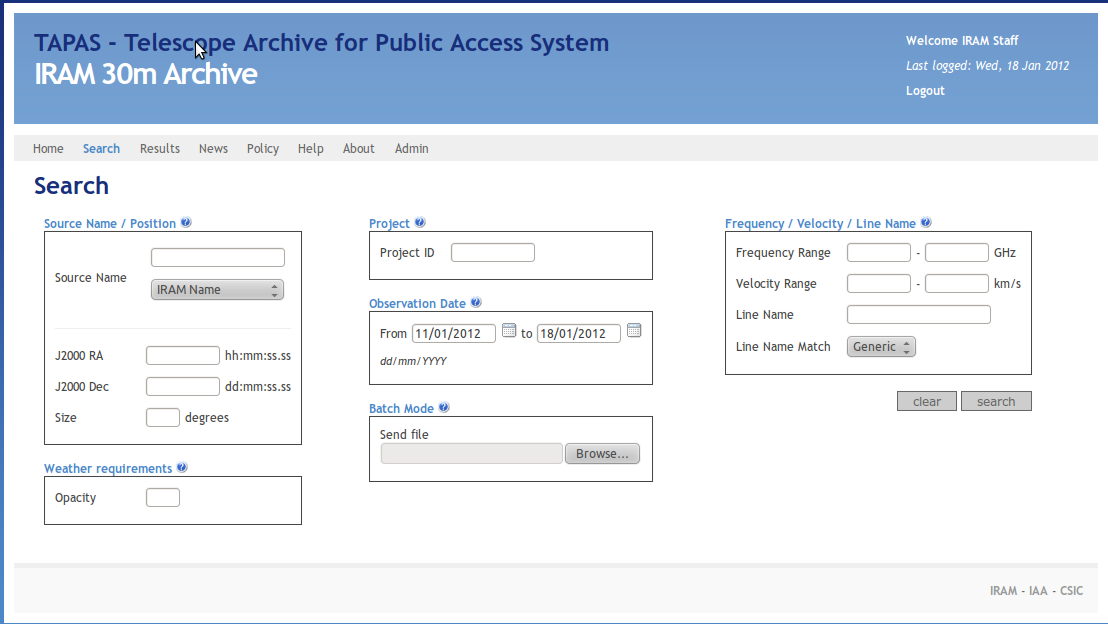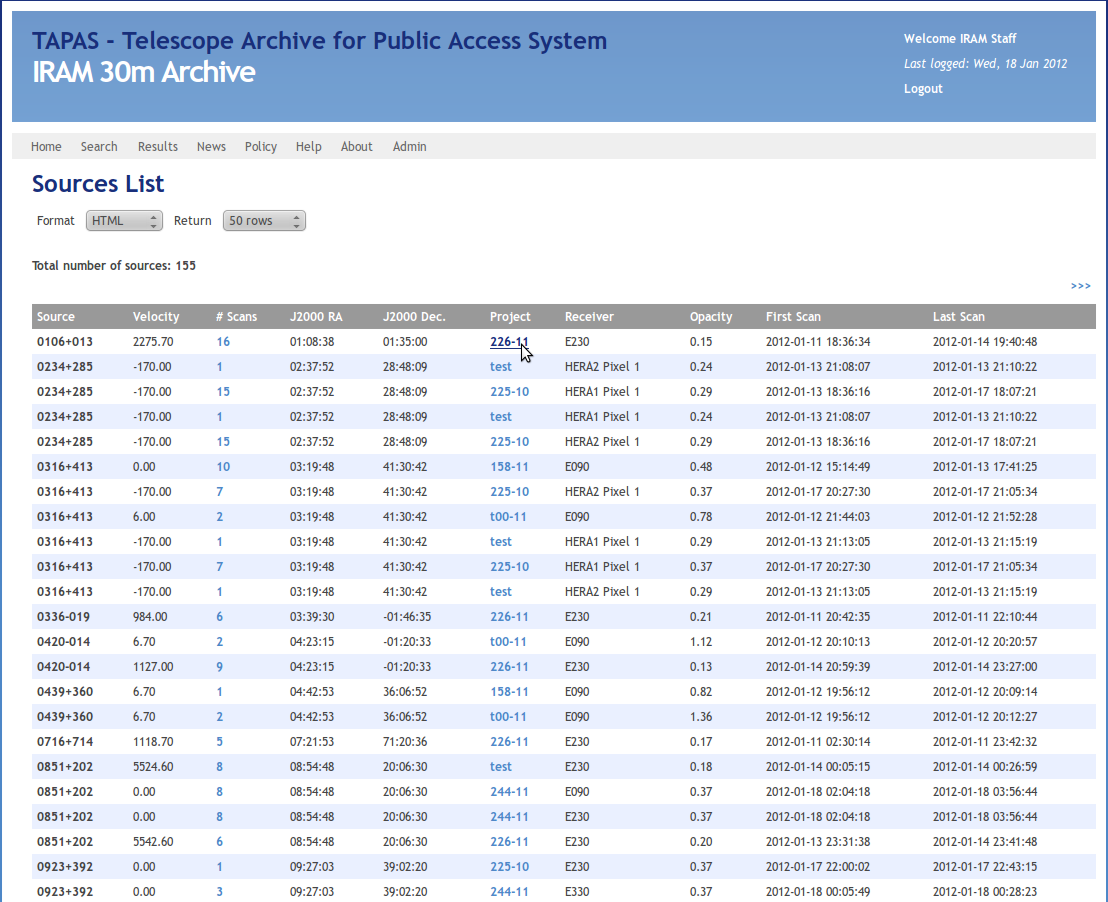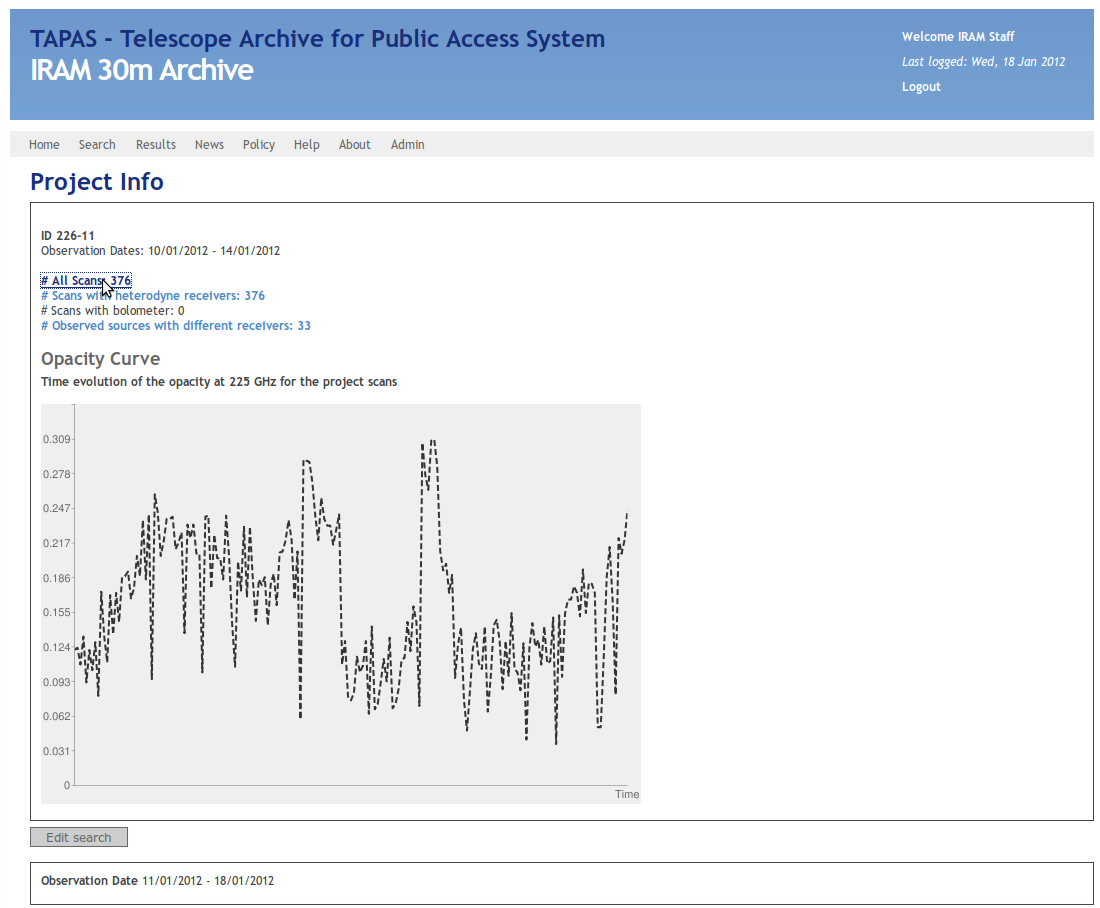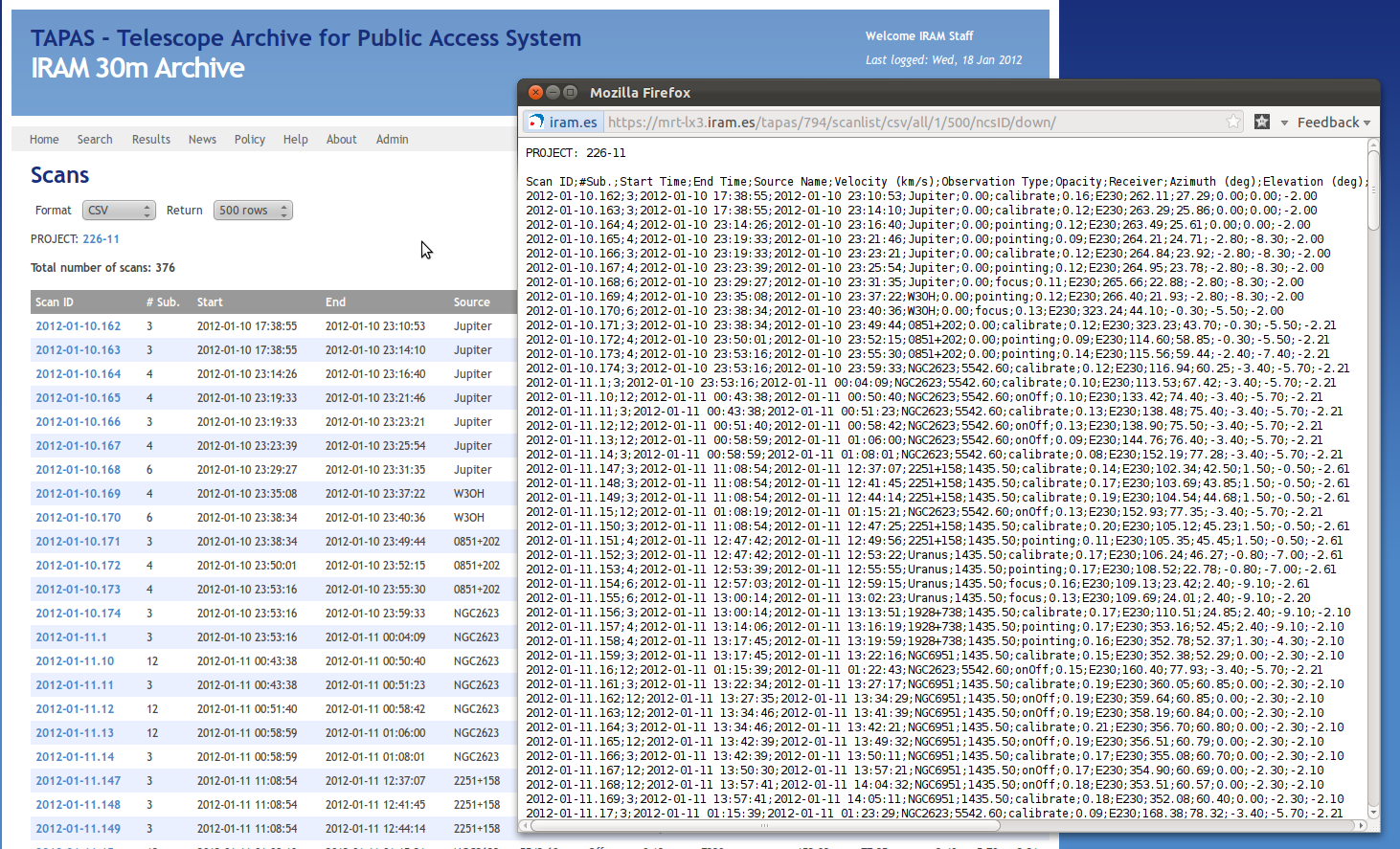|
Size: 3017
Comment:
|
Size: 3523
Comment:
|
| Deletions are marked like this. | Additions are marked like this. |
| Line 1: | Line 1: |
| = How To create the Pointing Plot = | = How To create the Pointing Plot = |
| Line 15: | Line 15: |
| == Get the Pointing results from Projects == | == Get the Pointing results from Projects == |
| Line 19: | Line 19: |
| Please ask the computer group or me for the login details in case you don't know. | Please ask the computer group or me (CB) for the login details in case you don't know. |
| Line 21: | Line 21: |
| After logging in go to the search form and enter the time range you want | After logging in, go to the search form and enter the time range you want |
| Line 25: | Line 25: |
| Now you'll obtain a somewhat confusing list of scans and projects that have been observed during that time: |
|
| Line 28: | Line 26: |
| To get the pointing results and the data format the program reads you have to select one project like shown in the previous image (Project 266-11). Clicking on a project name leads you to this page: |
|
| Line 31: | Line 27: |
| Where you have to selcet the link '#All Scans' like indicated in the image. Now you'll get a list of all scans made in this project. |
{{attachment:searchForm2.png||width=70%}} |
| Line 34: | Line 29: |
| Note, that thus the scans may excced the time range you have selected at the beginning. Long projects like the flux-monitoring easily cover months, if not years. |
|
| Line 37: | Line 30: |
| On the top of the page you can adjust the number of scans shown by changing the number of Rows. This number should be always larger than the number of total scans to get all the scans. Then to get the information in the format the pyhton script accepts you have to change "Format" to CSV. This results in a pop up that is also displayed in the previous image. |
|
| Line 41: | Line 31: |
| == Creating the input File for the Python Script == | Now you'll obtain a somewhat confusing list of scans and projects that have been observed during that time: |
| Line 43: | Line 34: |
| The information in the format displayed in the pop up is what the python script expects. | {{attachment:selectProject2.png||width=70%}} To get the pointing results and the data format the program reads you have to select one project like shown in the previous image (Project 266-11). Clicking on a project name leads you to this page: {{attachment:scan2.png||width=70%}} Here you have to select the link '#All Scans' like indicated in the previous image. Now you'll get a list of all scans made in this project: {{attachment:List2.png||width=70%}} Note, that the scans may exceed the time range you have selected at the beginning, since this page displays all scans of a project. Long projects like the flux-monitoring easily cover months. On the top of the page you can adjust the number of scans shown by changing the number of Rows. This number should always be larger than the number of total scans to assure that all scans are displayed. Finally, to get the information in the format the pyhton script accepts you have to change "Format" to CSV. This results in the pop-up that is also displayed in the previous image. == Creating the input File for the Python Script == The information displayed in the CSV pop-up is what the python script reads. |
| Line 48: | Line 82: |
| Into this text file you just need to copy the output displayed in the pop-up created by TAPAS. Important is that you '''don't''' copy the first three lines, i.e. the line staring with "Project" the empty line and the one starting with "Scan". |
Copy the output displayed in the pop-up created by TAPAS into this text file. |
| Line 51: | Line 84: |
| It is also important that there are no empty lines in pointFocus.txt! | == Creating the Plot == |
| Line 53: | Line 86: |
| == Creating the Plot== | '''Important''' for the script to work is that the PC that you are using has numpy and matplotlib, two python packages, installed. At the moment, without gra-lx4, only '''gra-lx18''', my machine, has the right preferences. |
| Line 55: | Line 90: |
| To create the plot, once you have the text file ready. You have to have '''plPotFoc.py''' and '''pointFocus.txt''' in the same directory and execute in the terminal: |
To create the plot, once you have the text file ready, you have to have log into gra-lx18 and having '''plPotFoc.py''' and '''pointFocus.txt''' in the same directory '''gra-lx18''' you need to execute in a terminal: |
| Line 59: | Line 94: |
| ''' python plPotFoc.py ''' | ''' python plPointFoc.py ''' |
| Line 64: | Line 99: |
| == Plotting more than one project== | |
| Line 66: | Line 100: |
| To plot more than one project you just have to add the content of the CSV pop-up of the projects to '''pointFocus.txt''', every time without the first three lines and letting no line empty: |
== Plotting more than one project == To plot more than one project you just have to add the content of the CSV pop-up of the all projects to the same '''pointFocus.txt'''. |
| Line 71: | Line 107: |
| == Future Ideas == We plan to develop a script that directly accesses TAPAS and thus is much easier to handle. So long please stick with this cumbersome way of creating the plot. Once used to it, it does not take more than 5 minutes. |
How To create the Pointing Plot
Download the Python Script
First off all you need the up-to-date version of the python script "plPoiFoc.py" that creates the plot. This can be downloaded here:
http://bazaar.launchpad.net/~ascurion/+junk/plPoiFoc/files
If you want you can contribute to the code via launchpad or send me changes you made so that I can include them. Any suggestions and improvements are welcome.
Get the Pointing results from Projects
Enter the Tapas webpage: https://mrt-lx3.iram.es/tapas/ . You'll have to log in with staff permissions to see the information of all projects. Please ask the computer group or me (CB) for the login details in case you don't know.
After logging in, go to the search form and enter the time range you want to display the pointing results for:

Now you'll obtain a somewhat confusing list of scans and projects that have been observed during that time:

To get the pointing results and the data format the program reads you have to select one project like shown in the previous image (Project 266-11).
Clicking on a project name leads you to this page:

Here you have to select the link '#All Scans' like indicated in the previous image. Now you'll get a list of all scans made in this project:

Note, that the scans may exceed the time range you have selected at the beginning, since this page displays all scans of a project. Long projects like the flux-monitoring easily cover months.
On the top of the page you can adjust the number of scans shown by changing the number of Rows. This number should always be larger than the number of total scans to assure that all scans are displayed. Finally, to get the information in the format the pyhton script accepts you have to change "Format" to CSV. This results in the pop-up that is also displayed in the previous image.
Creating the input File for the Python Script
The information displayed in the CSV pop-up is what the python script reads. To get the script to work you'll need to create a text file that is called exactly:
pointFocus.txt
Copy the output displayed in the pop-up created by TAPAS into this text file.
Creating the Plot
Important for the script to work is that the PC that you are using has numpy and matplotlib, two python packages, installed. At the moment, without gra-lx4, only gra-lx18, my machine, has the right preferences.
To create the plot, once you have the text file ready, you have to have log into gra-lx18 and having plPotFoc.py and pointFocus.txt in the same directory gra-lx18 you need to execute in a terminal:
python plPointFoc.py
This will print out the mean pointing and focus corrections on the screen. And create the pointing plot named: plPoiFoc.eps.
Plotting more than one project
To plot more than one project you just have to add the content of the CSV pop-up of the all projects to the same pointFocus.txt.
Future Ideas
We plan to develop a script that directly accesses TAPAS and thus is much easier to handle. So long please stick with this cumbersome way of creating the plot. Once used to it, it does not take more than 5 minutes.
